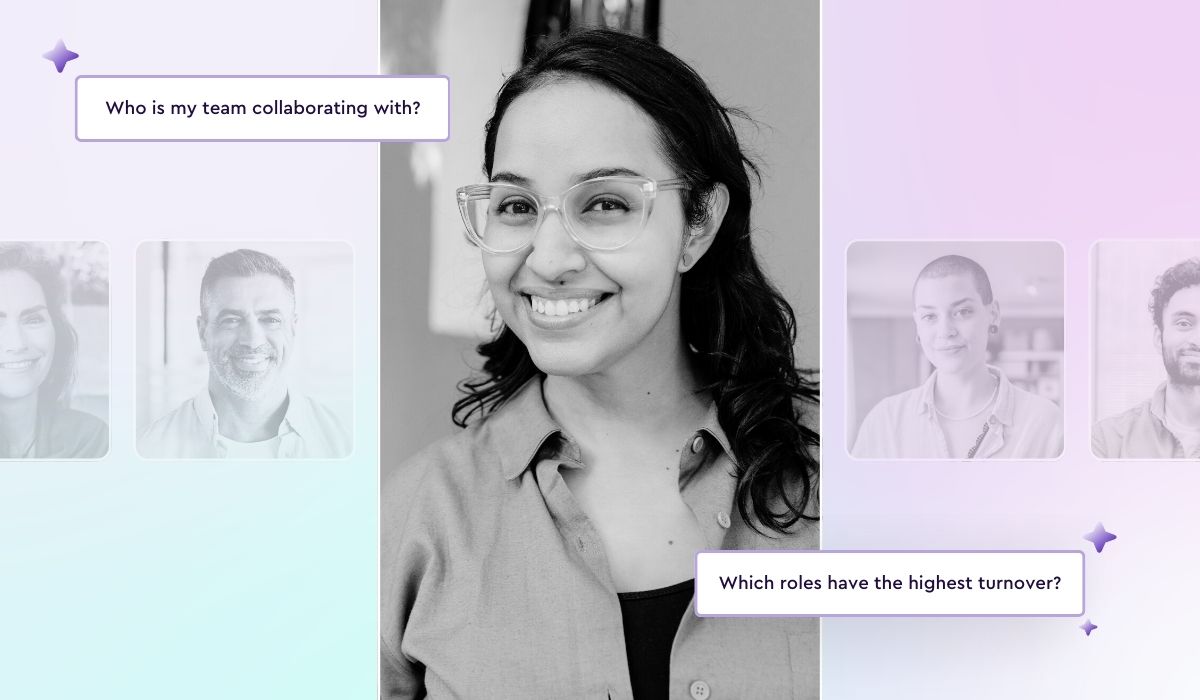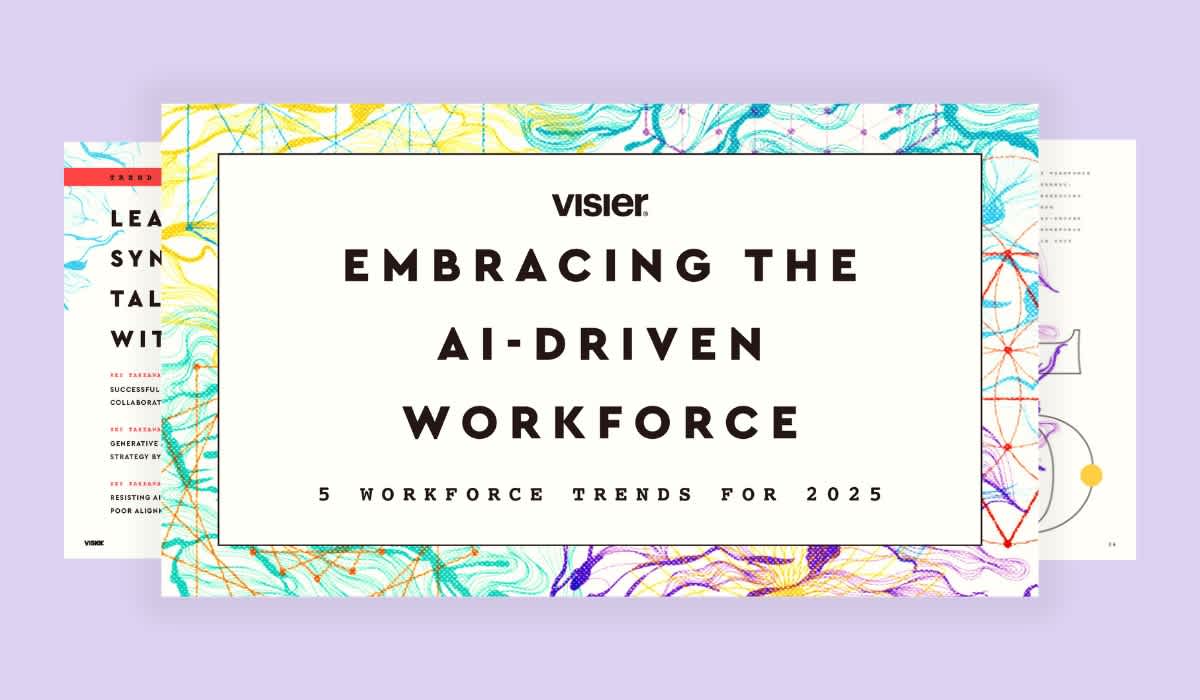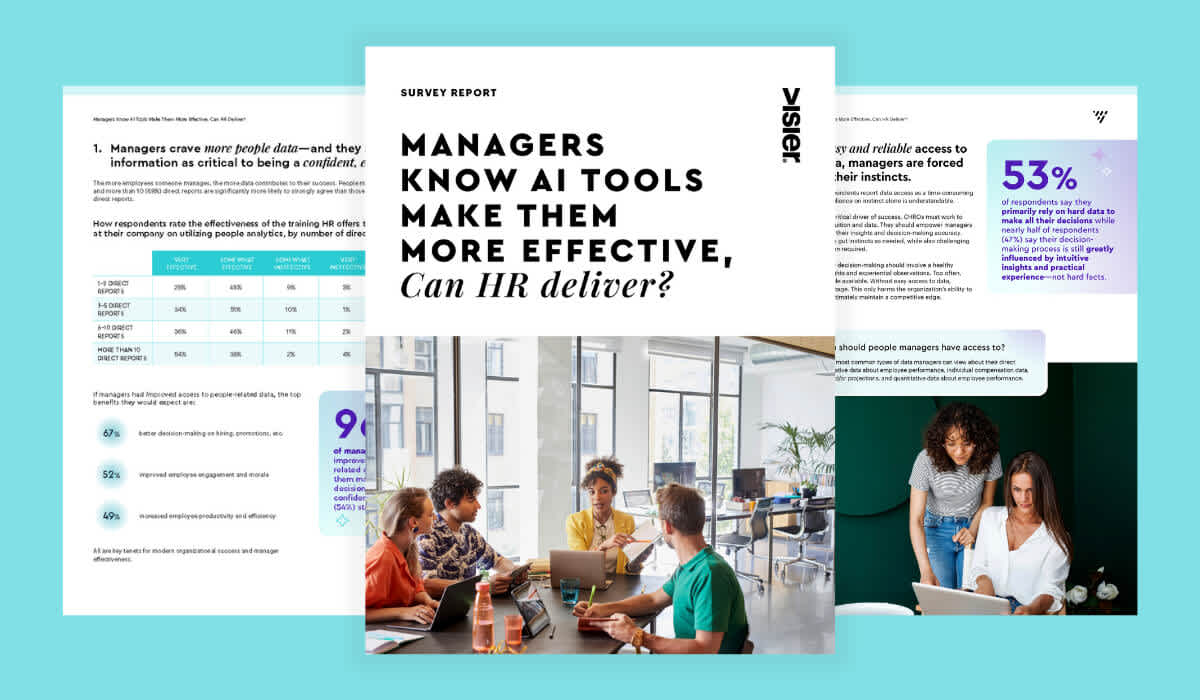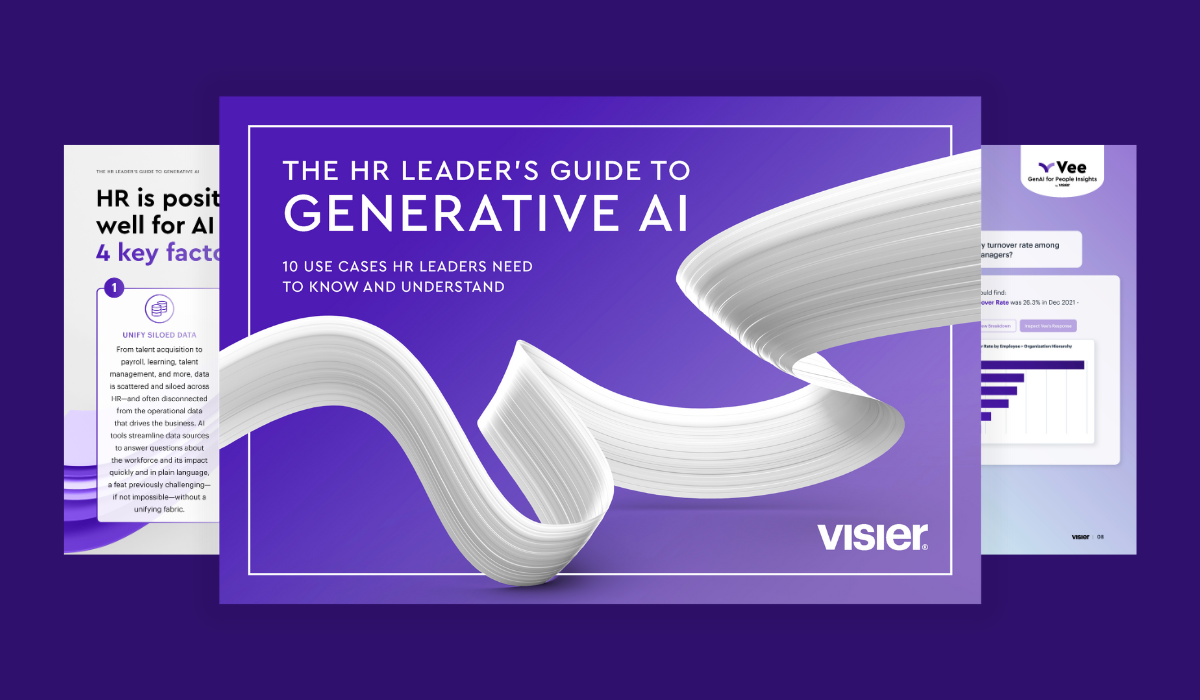10 People Analytics Questions Vee Can Answer in Seconds
What questions can you ask Gen AI? Here are 10 questions Vee can answer in seconds to help teams and managers get critical insights faster.

This post is part of a series of questions to ask generative AI for people analytics. Explore other posts in the series to learn which questions AI can answer for compensation and total rewards teams, HRBPs, workforce planning leaders, people analytics leaders, frontline managers, and CHROs.
Artificial intelligence can be an amazing tool for you and your company. AI analytics tools can help you improve employee retention, engagement, and even productivity. When used correctly, generative AI can provide insights that would otherwise be challenging—if not impossible—to see. Vee, Visier's generative AI digital assistant, makes it easier than ever for analytics teams and people managers to get the insights they need, when they need them.
76% of HR leaders agree they will be lagging in organizational success if they don’t adopt and implement generative AI in the next 12 to 24 months.
Gartner
In this post, we’ll explore how you can leverage generative AI for HR and people analytics, the best questions to ask AI for instant workforce insights, and key strategies for optimizing your AI use.

Using AI in human resources
Artificial intelligence tools have advanced dramatically over the past few years. HR has seen a steady increase in automation tool usage. The first applications automated tedious, repetitive tasks like payroll and record keeping.
Later, advanced analytics were introduced with performance management systems and predictive analytics tools that allowed better workforce planning.
Shortly after, screening tools entered the stage, improving the recruitment process and reducing the time to hire. Generative AI laid the groundwork for conversational tools like Vee.
![[VIDEO] Vee Sizzle [Sept 2024]](https://images.ctfassets.net/lbgy40h4xfb7/1pH73ccwQ3m1VArBourhtz/27c554891d679ce31f4f2d0a2ada9c79/vee-gen-ai-analytics-sizzle.jpg?w=1920&h=1080&fl=progressive&q=50&fm=jpg)
Generative AI for HR and people analytics
Generative AI is particularly good at ingesting a question, interpreting that language, and responding with answers and specific guidance that are easy for end users to understand. Its ability to follow question strings makes it easy for users to ask follow-up questions in conversational language. With a generative AI assistant like Vee, this becomes instantly easy and accessible.
In a recent Visier survey, 96% of managers agreed that improved access to people-related data would help them make decisions more confidently.
Vee is uniquely tailored to the HR and People Analytics domain, having undergone training on data from Visier's guidebooks and benchmarks, totaling over 250 million normalized, well-structured, anonymized values.
Its intuitive conversational interface pairs relevant visual representations and data visualizations with clear narrative responses to complex workforce questions, giving users the context and insights they need no matter their level of data literacy.
Vee is built on Visier's robust security model, leveraging role-based permissions to show the right answers to the right users when they need them. This makes self-serve analytics a reality at an unprecedented pace.
"Vee serves as a bridge between questioning and understanding. Vee cultivates user engagement and enhances data comprehension by providing simplified access to critical information without requiring expertise in emerging technologies.
-Ellen Gentile, HR Analytics Manager, Ascension
How to ask AI a question
The accuracy of your AI results depends on two important factors: the data you use and the questions you ask. The better questions you ask, the more likely you are to find the answers right away. But how do you know what makes a good question? There are a few best practices to keep in mind.
Use concise language. Avoid using jargon, or complicating yourself with unnecessarily complex language. Go straight to the point and ask your question as simply as possible.
Avoid ambiguity. Stick to the facts and avoid ambiguous or emotionally loaded questions.
Provide background information when needed. Sometimes, you can (and should) get right to the point. Other times, you’ll need to provide the AI with additional data so that its answer can be relevant to your particular context.
Be ready with related questions. Sometimes, AI won’t get it right on the first try. Provide more context, rephrase the question, or provide additional questions to steer it in the right direction.

10 questions to ask AI for instant workforce insights
Vee translates your question into a query and uses generative AI to come back with an accurate answer based on your organization’s people data within Visier. Here are 10 questions to ask Vee:
1. Which high performers have the greatest risk of leaving in the next year?
A simple, yet critical question for any company. You’ll need to use it alongside people analytics to have a good idea of turnover trends over the past year and an estimate of next year’s trends.
![[VIDEO] Vee Most @ Resignation Risk](https://images.ctfassets.net/lbgy40h4xfb7/IdUa1RgRIehXvd9FjoyDM/5b5bd480367df652a8872d299f7e9eac/vee-by-visier-percentage-resignation.jpg?w=1200&h=700&fl=progressive&q=50&fm=jpg)
2. Which high performers have the lowest compensation ratio?
Compensation is a critical element in retention, engagement, productivity, and performance. AI can help you quickly calculate the compa-ratio and see which top performers have the lowest one.
3. Which roles have the highest turnover?
You can use this question on its own or as a precursor to the above. The accuracy of your data will be critical here so that you—and the AI—can get a complete view of turnover trends.
4. Tell me about <Insert Employee Name>.
Not every question you ask AI needs to be about complex calculations. Sometimes you can use it to gain some insights about one employee or a team. This is especially useful in large companies, where HR will inevitably lose track of who is who.
Instead of wasting time trying to find their file, or their resume, asking AI for a quick summary of the most important information can save a lot of time.
5. What percentage of my team is women?
See the gender composition of your team to track and assess DEIB initiatives and identify potential areas for improvement in gender representation and equity.
![[VIDEO] Percentage of women Vee](https://images.ctfassets.net/lbgy40h4xfb7/3getWB1gF7sOF1P589Y5hp/6d6d89dab6cac1e9146cf4028df7ca0d/vee-by-visier-percentage-women.jpg?w=1200&h=700&fl=progressive&q=50&fm=jpg)
6. How does my team's diversity compare to industry benchmarks?
Rather than manually finding and sorting through all industry benchmarks and comparing them to the company’s numbers, ask Vee. In most cases, AI can answer this question quickly, and allow you to dig in for deeper insights.
7. Which employees abandoned learning activities?
Knowing who abandoned a learning activity can tell you a lot about a person’s interest and can help you create a more personalized L&D program for them in the future.
8. Does turnover correlate with employee NPS?
Understanding turnover rates alongside employee Net Promoter Scores (NPS) can help identify areas for improvement in the employee experience and inform strategies to enhance retention and engagement. Use this information to determine whether there is a correlation between employee satisfaction and retention.
9. Show me candidates by their current employer.
Understanding where candidates are currently employed can inform recruitment strategies, identify competitor talent, and tailor messaging to attract top candidates from specific organizations.
10. Which jobs are the hardest to fill?
Understanding which jobs are hardest to fill allows organizations to adjust recruitment strategies, explore alternative sourcing channels, and address potential skill shortages. Ask Vee follow-up questions about compensation, for instance, to inform your talent acquisition strategy.
![[VIDEO] Vee "How Hard to Fill"](https://images.ctfassets.net/lbgy40h4xfb7/5vRytF2BjZS6PXHFqDAnA9/b05ef663097b521779034dbd99147fca/vee-by-visier-percentage-hard-to-fill.jpg?w=1200&h=700&fl=progressive&q=50&fm=jpg)
How to use Visier’s Vee to automate and enhance HR and people analytics
Generative AI can transform and enhance your HR and people analytics processes. With accurate data and clear, concise questions, you can gain deeper data-driven insights into the most important aspects of your business.
Vee is a digital assistant with no learning curve that can answer all your HR and people-related questions. It has a user-friendly interface and simplifies access to the data so that even those with little knowledge of AI and analytics can start using it immediately.
Privacy and security are built-in which means you can carry on your work without worrying about any of those issues.
When used correctly, generative AI will help you create a more solid workforce and improve things like retention, productivity, and engagement. It can boost your diversity efforts and focus on creating a better employee experience for everyone and reach your business goals.

Generative AI for people analytics and HR
Vee, Visier’s generative AI digital assistant delivers fast, intuitive, accessible workforce insights to people leaders. Learn the latest product updates here.
To keep up with the future of work, HR leaders need a strategy that's agile, adaptable, and rooted in data. GenAI can help close the gap between people data and business data. Ian Cook and Robert Sullivan share how.
Visier's genAI assistant, Vee, answers people analytics leader's questions about the workforce in seconds. Here are 10 real examples of answers from Vee.
Generative AI innovations like digital assistants are changing the way we work, and pose significant security challenges. Are they secure enough to use with people data?
Interested in more AI innovation from Visier? Check out Vee Boards: AI-augmented insight boards, laser-focused on specific issues of top concern to the C-suite. Learn more here.
FAQs about generative AI for HR
1. What are the main benefits of using generative AI in HR?
Generative AI improves HR efficiency by automating tasks, providing deeper data insights, and helping HR teams make informed decisions about retention, productivity, workforce planning, compensation planning, performance management, and more.
2. Is generative AI safe for handling sensitive HR data?
Generative AI systems like Visier's Vee use robust security protocols, including encryption and role-based permissions, ensuring that only authorized users can access sensitive data.
3. Can AI help with diversity and inclusion initiatives?
Yes. AI can track diversity metrics, benchmark them against industry standards, and suggest strategies for improvement, making it a valuable tool for advancing DEIB goals.


